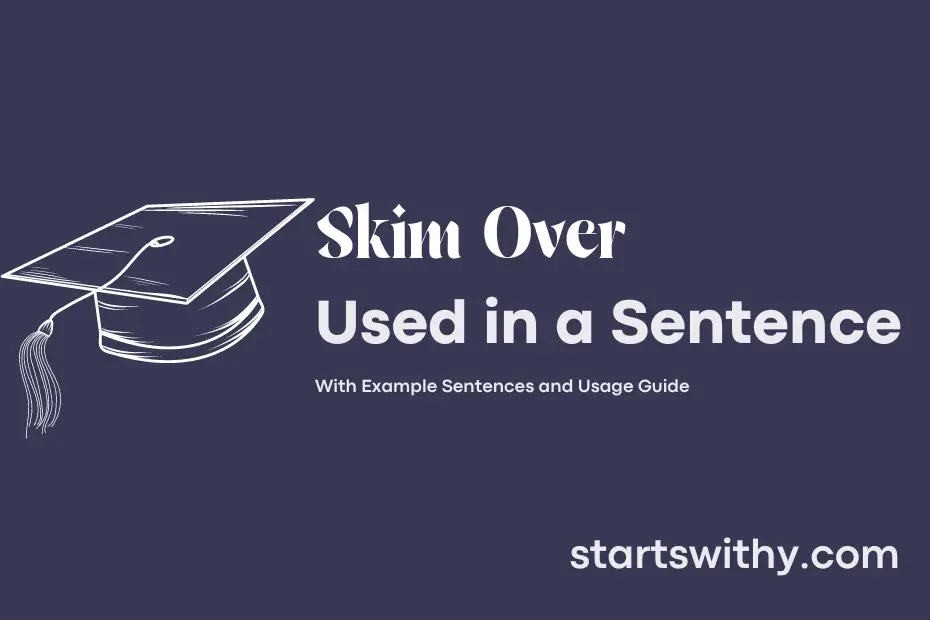Have you ever read something quickly, barely grasping the main points? This practice is commonly known as “skimming over,” where the reader glances through the text to get a general idea without delving into the details. Skimming over is a useful skill when going through lengthy documents or when time is limited.
When you skim over a piece of writing, you are essentially scanning for key information without focusing on every word. This approach allows you to quickly identify main ideas, highlight essential points, and decide whether the content is worth a more thorough read.
7 Examples Of Skim Over Used In a Sentence For Kids
- The bird will skim over the pond to catch a fish.
- The butterfly will skim over the flowers in the garden.
- The boat will skim over the water at the beach.
- The clouds will skim over the sky on a sunny day.
- The rabbit will skim over the grass in the field.
- The kite will skim over the sky during a windy day.
- The ball will skim over the ground when kicked.
14 Sentences with Skim Over Examples
- Skim over the textbook before the lecture to have a better understanding of the topics.
- Make sure to skim over the important points in your notes before the exam.
- It’s usually helpful to skim over the syllabus at the beginning of the semester to plan your study schedule.
- Take the time to skim over the recommended readings for your assignments.
- Skim over the previous year’s question papers to get an idea of the exam pattern.
- Don’t forget to skim over your presentation slides before presenting in class.
- You can quickly skim over the chapter summaries to review the main ideas before the quiz.
- It’s a good idea to skim over the online resources provided by the professor for additional information.
- Before starting your research paper, skim over relevant articles to gather information.
- Take a few minutes to skim over the key points in your group study notes before the group discussion.
- You can skim over the content of the workshop to decide if it aligns with your interests.
- Skim over the assignment guidelines to make sure you are meeting all the requirements.
- Use the table of contents to quickly skim over the chapters in the textbook.
- Remember to skim over the feedback provided by your professor on previous assignments.
How To Use Skim Over in Sentences?
Skim Over is a phrasal verb that means to read or look through something quickly without paying close attention to details. It is often used when one wants to get a general idea of something without focusing on every single aspect. In a sentence, the main word that signifies using this action is Skim Over.
Here is an example of how to use Skim Over in a sentence: “I don’t have much time, so I will skim over this report to see if there are any important points I need to know.”
To effectively use Skim Over in a sentence, remember to place it after the subject of the sentence and before the object or additional information. This helps to clearly indicate that you are referring to quickly looking through something without delving into the details.
When utilizing Skim Over, keep in mind the context in which you are using it. Ensure that the sentence conveys the intended meaning and that the action aligns with the purpose of quickly reviewing information.
Practice using Skim Over in various sentences to become more comfortable with incorporating it into your language. This will help you communicate more efficiently and accurately when you need to express the act of briefly examining something.
Conclusion
In conclusion, while skimming over information can help save time and grasp the main points quickly, it may also lead to missing important details or nuances. It is essential to strike a balance between skimming for efficiency and diving deeper for comprehensive understanding. When skimming over content, it is crucial to pay attention to key terms, headings, and summaries to extract the most vital information without overlooking critical elements. By utilizing skimming techniques effectively, individuals can efficiently navigate through vast amounts of content while still ensuring a good level of comprehension and retention. It is important to acknowledge the limitations of skimming over information and to utilize it as a tool in conjunction with deeper analysis when necessary.



